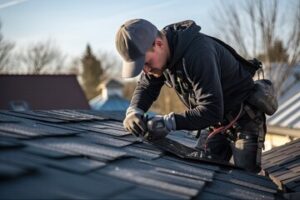Greensboro Landscaping adds beauty and value to your property and provides a comfortable, functional outdoor living space. Proper landscaping can also increase energy efficiency and support environmental conservation.

Balance, proportion, and unity are important principles to consider in your landscape design. For example, use a variety of plants with different textures to create contrast and a unified look.
A lush lawn enhances the appearance of any property and adds to its value. It’s also a great place for children and pets to play, plus it keeps dirt and dust from blowing into your house. A well-manicured lawn can make your home or business look more inviting to guests, and it also improves air quality by filtering pollutants and absorbing carbon dioxide.
Choosing the right type of grass for your landscape can be difficult, but there are two popular options: sod and artificial turf. Each has its own advantages and disadvantages, depending on your needs and lifestyle.
Sod is a popular choice for many homeowners, and it’s typically installed during the spring and fall when soil temperatures are more ideal for sod establishment. It’s more expensive than establishing a new lawn from seed, but it offers the instant gratification of a full, green lawn that’s ready to be used immediately.
While sod is typically used for full-scale lawns, it can be used as a substitute for a portion of a yard or even to cover other types of surfaces such as a putting green or dog area. The benefits of sod include its durability and ability to withstand high levels of traffic and wear. It doesn’t need to be watered as often as a traditional lawn, but it’s important to note that it still requires regular maintenance in order to stay healthy and beautiful.
The types of sod available vary by region, with warm-season varieties being grown in the southern states and cool-season grasses in the north. The type you choose will depend on your local climate and average weather patterns, with some varieties suited better for sunny areas than others.
Zoysia is one of the most common and versatile sod varieties in Orlando, as it’s green all year, dense, and has excellent drought recovery. It also resists weeds, tolerates heavy foot traffic, and is low-maintenance in general. However, it doesn’t thrive in shade and may require more frequent mowing than other sun-loving varieties such as St. Augustine Floratam or Zoysia Palisades.
Hardscaping
While softscaping may come to mind first when you think of landscaping, hardscape is an equally important part of your home’s outdoor design. The term “hardscape” refers to the non-living, non-organic components of landscape design that add texture and contrast to your garden. Hardscape features include anything from stones, bricks and gravel to concrete pavers, patios, decks, pergolas and other architectural structures.
Adding hardscape elements to your yard can increase the functionality of your space by creating designated areas for activities like walking, relaxing and entertaining. This can also reduce your maintenance costs by removing the need to water and weed regularly. Choosing materials with a low solar reflectivity index can help keep your outdoor area cooler as well.
Hardscape features can also be designed for aesthetic purposes. For instance, the use of boulders or a focal point such as a statue or fountain can draw the eye and focus attention on your outdoor living spaces. Alternatively, the use of different pavers or colors can create a distinct look that suits your property’s style and function.
The most functional elements of your hardscape are likely to be walkways and paths. Not only do they provide access throughout your landscape, but they can also reduce the amount of lawn you need to maintain by eliminating the need for grass or groundcovers. Additionally, the installation of retaining walls can prevent soil erosion and help manage stormwater drainage, preventing pollutants from being carried into lakes, rivers or oceans.
While a balance between softscape and hardscape is crucial to any landscape design, it’s also important to remember that your hardscape elements shouldn’t compete with or detract from the beauty of your plants and trees. Instead, they should complement and enhance them, acting as a visual counterpoint that draws the eye to certain areas of your garden and creates a sense of harmony and balance in your yard. The best way to ensure this is to enlist the services of experienced and trusted professionals. They can conduct a comprehensive site evaluation and offer advice on the best ways to incorporate and integrate your hardscape with the surrounding vegetation.
Plants
A good landscaper knows the importance of using plants that are appropriate for each particular environment. For instance, a mountain landscape requires a different set of plants than a coastal one. Plants that are adapted to dry environments (like cactuses and succulents) do not thrive in wet areas (such as gardens or ponds).
Landscapers also understand the difference between a softscape and a hardscape. The former involves living horticultural elements like trees, shrubs and flowers, while the latter refers to non-living landscaping elements such as paving materials and structural structures like walkways and patios.
Using color and line to draw the eye is also an important element of landscape design. For instance, a statue may be highlighted with a bed of vibrant red or yellow flowers, while a water feature can add soothing sound and visual movement. In addition, a landscaper must consider the use of proportion and scale. A large tree should not overwhelm a small garden, while a tiny flower should not be dwarfed by a massive boulder.
Another important part of commercial landscape design is incorporating features that improve usability and support outdoor activities. For example, creating seating areas that are both comfortable and functional allows employees to take a break without leaving the office. The inclusion of electrical receptacles ensures that employees can recharge their electronic devices, as well.
A well-designed and maintained commercial landscape can also increase a business’s revenue. Studies show that customers are more likely to spend money at businesses that appear clean and organized, including the surrounding outdoor space. Additionally, people tend to spend more time at parks and botanical gardens that are well-maintained and cared for.
In addition to aesthetics, a commercial landscaper must also consider environmental sustainability. This is particularly crucial in urban settings, where pollutants are at a higher concentration than in rural areas. The use of native vegetation and low-water irrigation systems can help combat this issue.
Outsourcing rates are expected to rise this year due to a growing demand for landscape services and labor shortages. This is particularly true for larger companies that can leverage their size to navigate the labor market and obtain preferential pricing on material supplies.
Maintenance
A well-maintained landscape will add beauty and value to your property, as well as provide a welcoming environment for guests, customers, and employees. But maintaining your landscape takes more than just regular mowing and trimming. It requires an understanding of how each component interacts with one another, as well as a deep knowledge of the science behind horticulture.
Landscaping is the art of designing, constructing, and maintaining outdoor spaces that incorporate plants, trees, and grass to create visually appealing environments. It also includes altering the terrain to improve drainage, usability, and aesthetics. Unlike gardening, which focuses on the care and cultivation of individual plants, landscaping provides a more holistic approach that balances creativity with practicality.
Using plant species that thrive in the local climate, a professional landscaper can enhance the natural beauty of your outdoor space by providing color, texture, and seasonal interest. This is done through a wide array of services that include planting, fertilization, weed control, mulching, and pruning.
Irrigation system design and installation, routine inspections, and timely repairs help your landscape operate at peak efficiency year-round. Preventative weed control and disease management helps ensure that your lawn and beds stay healthy, while minimizing the use of harsh chemicals.
Tree and shrub plantings offer shade, privacy, and visual appeal to your yard, as well as enhance the value of your home or business. A landscaper can install trees that will grow to meet your needs and provide a lifetime of enjoyment.
Water features, such as fountains, ponds, and waterfalls, introduce soothing sounds and movement to outdoor spaces. They can also be used to mask noise pollution or provide a focal point for outdoor seating areas.
While some homeowners try to tackle landscape maintenance on their own with the latest DIY hacks, professional landscaping services can save you time, money, and the frustration of doing it yourself. The nine essential commercial landscaping services listed below will keep your property looking its best all year round. This will allow you to focus on what matters most, knowing that your commercial property is in good hands.


